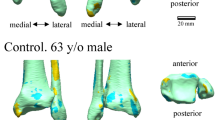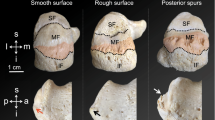Abstract
Objective. To determine the relationship between sites of calcaneal plantar enthesophytes and surrounding fascial and soft tissue structures using routine radiography, MR imaging, and data derived from cadaveric and paleopathologic specimens.
Design and patients. Two observers analyzed the MR imaging studies of 40 ankles in 38 patients (35 males, 3 females; mean age 48.3 years) with plantar calcaneal enthesophytes that were selected from all the ankle MR examinations performed during the past year. Data derived from these MR examinations were the following: the size of the enthesophyte; its location in relation to the plantar fascia (PF) and flexor muscles; and the thickness and signal of the PF. The corresponding radiographs of the ankles were evaluated at a different time by the same observers for the presence or absence of plantar enthesophytes and, when present, their measurements. A third observer reviewed all the discordant observations of MR imaging and radiographic examinations. Two observers analyzed 22 calcaneal specimens with plantar enthesophytes at an anthropology museum to determine the orientation of each plantar enthesophyte. MR imaging of a cadaveric foot with a plantar enthesophyte with subsequent sagittal sectioning was performed to provide further anatomic understanding.
Results. With regard to MR imaging, the mean size of the plantar enthesophytes was 4.41 mm (SD 2.4). Twenty (50%) enthesophytes were located above the PF, 16 (40%) between the fascia and abductor digiti minimi, flexor digitorum brevis and abductor hallucis muscles, and only one (3%) was located within the PF. In three (8%) cases the location was not determined. The size of enthesophytes seen with MR imaging and radiographs was highly correlated (P<0.01). The interobserver agreement for all measurements was good (Pearson >0.8, kappa >0.9). Eleven of the 22 bone specimens had plantar enthesophytes oriented in the direction of the abductor digiti minimi and 11 oriented in the direction of the flexor digitorum brevis and PF. The cadaveric sections revealed different types of enthesophytes.
Conclusions. Plantar calcaneal enthesophytes arise in five different locations: at the insertion sites of abductor digiti minimi and flexor digitorum brevis muscles; between the PF and these muscles; and, less frequently, within the PF and at the insertion site of the short plantar ligament.
Similar content being viewed by others
Author information
Authors and Affiliations
Additional information
Electronic Publication
Rights and permissions
About this article
Cite this article
Abreu, .M., Chung, .C., Mendes, .L. et al. Plantar calcaneal enthesophytes: new observations regarding sites of origin based on radiographic, MR imaging, anatomic, and paleopathologic analysis. Skeletal Radiol 32, 13–21 (2003). https://doi.org/10.1007/s00256-002-0585-x
Received:
Accepted:
Issue Date:
DOI: https://doi.org/10.1007/s00256-002-0585-x




